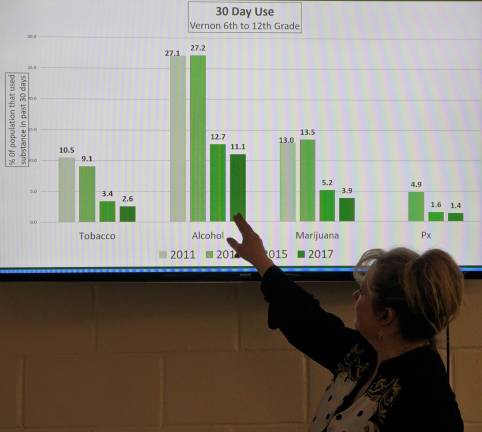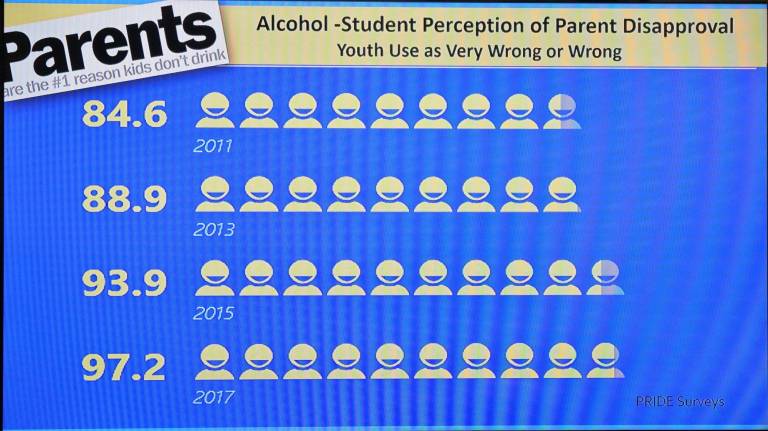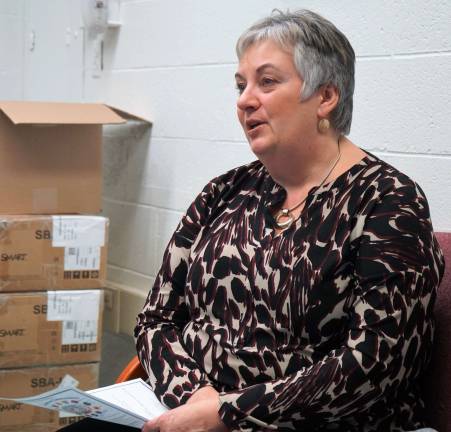Vernon Coaltiion releases drug survey results



VERNON — Vernon Coalition Coordinator Rebecca Dorney reviewed on March 14 the progress reflected in the latest PRIDE Survey – Risk and Protective Factor Student Perception Survey.
Dorney emphasized the survey is the “perception” of 879 Vernon Township sixth-12th-grade students, conducted anonymously by a third party. In addition, she said, it was the first year to receive 398 validated parent surveys, which were collected the first week of December 2017.
As a stipulation of the Vernon Coalition grant, Dorney said, four core measure questions are reported to the federal government: past 30 day use of tobacco – not including vaping - alcohol, marijuana, and prescription drugs; perception of harm; plus, parental and friend disapproval for the four substances.
Vaping will be included in the next survey, Dec. 2018; and the reporting data covers: 2011, 2013, 2015, and 2017.
Dorney said, “You can see how well we are doing in our community,” the 30-day alcohol use percentage went down from 27.1 percent in 2011, to 11.1 in 2017.
In addition, 30-day usage for marijuana went down from 13.0 percent in 2011, to 3.9 percent in 2017.
School Board member Lori Lepera said, going forward, all Vernon School System activities will require a minimum of 20 percent random drug testing. She said, it will be less punitive, because students will remain engaged and connected. The worst thing, Lepera continued, is to isolate a student who needs peer support and adult mentoring.
Dorney continued, the students' perception of harm for the four substances between 2015 to 2017 was tobacco: 88.1 percent to 90.6 percent — not including vapes; prescription drugs: 88.7 percent to 89.4 percent – Dorney said, it is good the prescription drug percentage went higher, because of the connection to heroin; marijuana: 72.2 percent to 67 percent; and alcohol: 86 percent to 83.9 percent.
Data comparing student to parent perceptions of harm for the four substances as risky or very risky behavior included: student perceptions of alcohol harm: 83.9 percent to parents: 88.9 percent; tobacco 90.6 percent to 87.4 percent; marijuana 67 percent to 85.7 percent; and prescription drugs 89.4 percent to 89.6 percent.
Dorney explained, the perception of harm is one of the biggest indicators of overall community use.
She added, the biggest gap of student perception of harm in comparison to parent perception was marijuana. Marijuana was the lowest perception of harm of all the substances with parents — 85.7 percent, in comparison to a much lower perception of risk for students at 67 percent.
Perception of parents' disapproval for youth alcohol use as wrong or very wrong– which she gave “huge kudos to the community” - went from 84.6 percent in 2011 to 97.2 percent in 2017.
With marijuana, she continued, student perception of parental disapproval of youth use was 86 percent, where 98 percent of parents said it was wrong or very wrong for youth to use marijuana.
Lepera said the data helps them know where they need to focus educating students, including the negative consequences of marijuana. She added they are hearing from too many others, “It's not as bad as they think it is.”
Dorney also spoke of protective factors, “assets,” or conditions which buffer youth by reducing the impact of risk, or how they will respond to the risk, including: strong bonds with family, school, community, and peers.
She encouraged parents, with the next Dec. 2018 survey, to “just hit submit” — even if unfinished. The coalition paid for 601 started surveys, although 398 were submitted and considered valid.
Dorney also said, the December 2018 survey will probably be the last coalition survey, because their 10-year capacity as a federally funded entity will come to an end. After that, it will be up to the community at large, she continued, to find the funds for continuing — if desired.